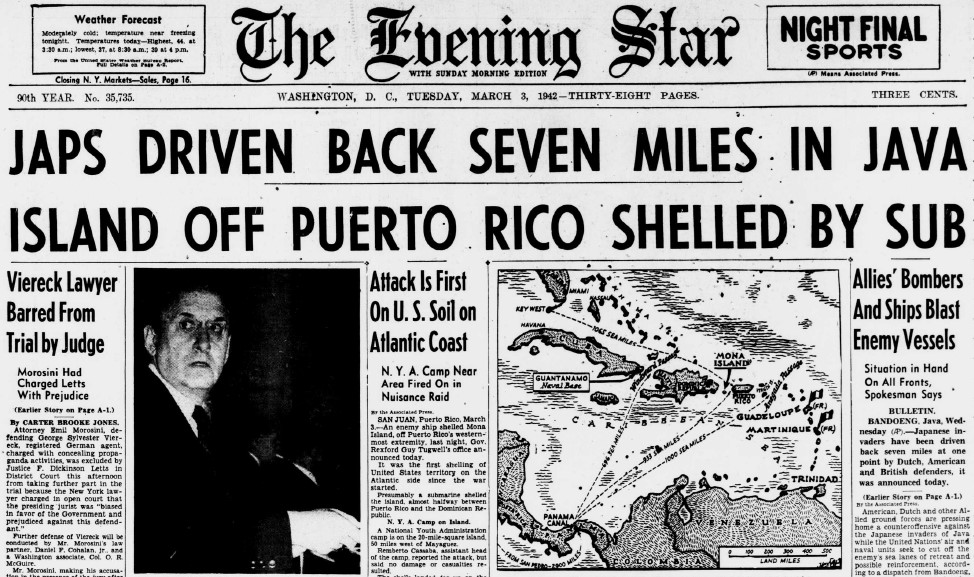World War II Chronicle: March 3, 1942
Click here for TODAY’S NEWSPAPER
On page two the Navy announces the sinking of the destroyer USS Jacob Jones off the coast of Delaware on Feb. 28… War Department communiques 131 and 132 on page 4… Sports section begins on page 16, which features a column from Grantland Rice
Also on page 16 is a story where Brooklyn Dodgers manager Leo Durocher brags that his club won’t have much difficulty defending their National League pennant this season. He feels that the Cardinals’ decision to unload first baseman Johnny Mize to the New York Giants was a boneheaded move. But was it? Stan Musial will have his first full season and the Redbirds have two young lefthanded prospects to take Mize’s place — Johnny Hopp and Ray Sanders.

Mize was not on good terms after contract holdouts and riding out the season after an injury watching Cardinal games from the stands and not in uniform where he could be called on to pinch hit. St. Louis dealt him to New York for three players and $50,000.
Was it a poor trade? According to the numbers, and if you only look at what they got in 1942, yes. But dealing Mize away wasn’t a disaster either.
1942
Mize: .305/.380/.521 (batting average/on-base percentage/slugging percentage)
Johnny Hopp: .258/.334/.382
Ray Sanders: .252/.351/.379
Mize hit 25 doubles, 7 triples, 26 homeruns, and drove in 110 runs while Hopp and Sanders combined to hit 33 doubles, 9 triples, 8 homeruns, and drove in 76.
1944
Both players continue to improve, and Sanders and Hopp both logged their best performances in 1944.
Sanders: .295/.371/.441 and knocked in over 100 runs
Hopp, now an outfielder: .336/.404/.499
Combined, they hit 69 doubles, 18 triples, 23 homeruns, and 174 runs batted in. Comparing two pretty-good ballplayers to one superstar isn’t terribly fair, so let’s pair Mize and Hopp’s 1941 numbers (both had over 500 plate appearances): you end up with 64 doubles, 19 triples, 20 homeruns, and 150 RBI. Hopp and Sanders in 1944 beat out Hopp and Mize in 1941.
As for the players the Cardinals got in return: Bill Lohrman pitched 12 innings before the Giants bought him back, Johnny McCarthy spends all of 1942 in the minor leagues, and Ken O’Dea will be St. Louis’ backup catcher for the next five years. Not what you’d expect for one of the greatest lefthanded batters in St. Louis history, but what are you gonna do when he doesn’t get along with management?
This is speculation on my part, but with the war going on, perhaps it would be better to trade Mize before he is drafted into service; at least this way you get something in return. 1942 will be his last season as he spends the next three playing ball for Uncle Sam. This way, your talented — and cheaper — backups develop into starters. Not only do the Cardinals have the cash and the catcher they were looking for, it would be easier to bring up a replacement for Hopp or Sanders than it would to fill the gaping hole left by Mize.
Beginning on the front page is a story about Boston Red Sox slugger Ted Williams being reclassified. Williams was originally classified I-A, which means available and fit for military service — the category of men most likely to be drafted. He was reclassified III-A as he was the sole means of income for his mother, which military service would create a hardship for his family.
Here is a list of the categories during World War II:
| I | Available for service |
| I-A | Available; fit for general military service |
| I-A-O | Conscientious objectors eligible for military service in noncombatant role |
| I-B | Available; fit only for limited military service |
| I-B-O | Conscientious objectors available for limited service [not used after Aug. 18, 1942] |
| I-C | Members of land or naval forces of the United States |
| I-D | Students fit for general military service; available not later than July 1, 1941 |
| I-E | Students fit for limited military service; available not later than July 1, 1941 |
| I-H | Men deferred by reason of age [not in effect any more, as provision deferring men over 28 years of age had been repealed?] |
| II | Deferred because of occupational status |
| II-A | Men necessary in their civilian activity |
| II-B | Men necessary to national defense |
| II-C | Men necessary to farm labor |
| III | Deferred because of dependents |
| III-A | Men with dependents, not engaged in work essential to national defense |
| III-B | Men with dependents, engaged in work essential to national defense |
| IV | Deferred specifically by law or because unfit for military service |
| IV-A | Men who had completed service [not considered in time of war] |
| IV-B | Officials deferred by law |
| IV-C | Nondeclarant aliens |
| IV-D | Ministers of religion or divinity students |
| IV-E | Conscientious objectors available only for civilian work of national importance |
| IV-E-LS | Conscientious objectors available for limited civilian work of national importance |
| IV-E-H | Men formerly classified in IV-E or IV-E-LS, since deferred by reason of age |
| IV-F | Men physically, mentally or morally unfit |
